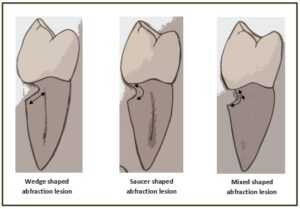What is dental abrasion?
Unlike dental attrition, abrasion is the loss of tooth structure by mechanical forces from a foreign element. If this force begins at the cementoenamel junction, then the progression of tooth loss can be rapid since enamel is thin in this region of the tooth. Once past the enamel, abrasion quickly destroys the softer dentin and cementum structures.
The appearance is commonly described as V-shaped when caused by excessive pressure during tooth brushing. The teeth most commonly affected are premolars and canines. Abrasion usually shows as worn, shiny, often yellow/brown areas at the cervical margin.
Abrasion is the wearing away of tooth surface caused by friction or a mechanical process. Abrasion happens when teeth are brushed too vigorously in sweeping horizontal strokes. The use of a hard toothbrush can also cause the problem.
It is often evident on the outer surfaces of the back teeth. A wedge or V-shaped indentation of the tooth will be seen at the gum margin. Toothbrush abrasion can be repaired by bonding a tooth-colored filling over the abraded area of the tooth.
Related Reading: How to Perform an Occlusal Analysis
Like what you’re learning? Take it a step further and test your clinical diagnosis skills with USC’s Virtual Patient Simulation.

Dental Abrasion Causes
Sources of tooth erosion from dental abrasion include:
- Vigorous horizontal tooth brushing
- Nail biting, pen biting, and pipe smoking
- Denture clasps
- Abrasive dentifrices
- Hard toothbrushes
What is Dental Abfraction?

Abfraction is the loss of tooth structure from flexural forces. This has not been supported by dental research, but it is hypothesized that enamel, especially at the cementoenamel junction (CEJ), undergo this pattern of destruction by separating the enamel rods.
As teeth flex under pressure, the arrangement of teeth touching each other, known as occlusion, causes tension on one side of the tooth and compression on the other side of the tooth. This is believed to cause V-shaped depressions on the side under tension and C-shaped depressions on the side under compression.
This theory does not fully satisfy many researchers because there are many teeth whose occlusion causes tension and compression on either side. Consequently, it would be expected that many more teeth would show signs of abfraction, but this is not the case. Research is ongoing to identify the role abfraction has on this pattern of tooth destruction.
What are the causes of abfraction?
Occlusal forces are blamed as they might cause the tooth to flex, causing small enamel flecks to break off, inducing the abrasive lesions. Usually, there are wedge-shaped lesions with sharp angles found at the cervical margins.
What has recent literature suggested about whether abfraction is real or not?
Bartlett DW, et al.’s critical review of non-carious cervical (wear) lesions and the role of abfraction, erosion, and abrasion, there is little evidence, apart from laboratory studies, to indicate that abfraction exists other than as a hypothetical component of cervical wear.
Stress Analyses in the Theory of Abfraction
A report by Litonjua LA et al. examines studies on mechanical properties of enamel and dentin and studies on bite forces and chewing.
Through their research, they found that abfraction is entirely based on FEM studies, and recent dental stress analyses have been contradictory. Newer studies include PDL and alveolar bone in the models, and new models show that occlusal forces dissipate and are not concentrated at the cervical region.
In conclusion, the key basis of the abfraction theory may be flawed.
Earn an Online Postgraduate Degree in Orofacial Pain and Oral Medicine
Are you interested in a variety of issues focused on orofacial pain, medicine and sleep disorders? Consider enrolling in the Herman Ostrow School of Dentistry of USC’s online, competency-based certificate or master’s program in Orofacial Pain and Oral Medicine.

